|
Brooks journal - Page 4
Page 1 | Page 2 | Page 3 | Page 4 | Page 5 | Page 6
8/16/03 - day 14 (day 5 leg 2) |
| A long day
|
We are further from solstice every day, and this evening I'm writing from an isolated hill in the fog. I'm not sure which of these factors is more responsible, but it is definitely harder to see my writing tonight. I am sleepy and sore, and both Hig and I had a hard time keeping our balance while untying shoes and undressing for bed. We've walked over 23 miles today, all in the East Fork Chandalar River valley.
|
 |
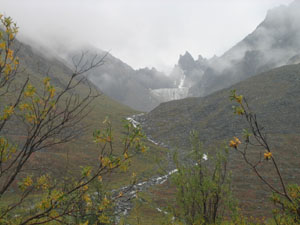 |
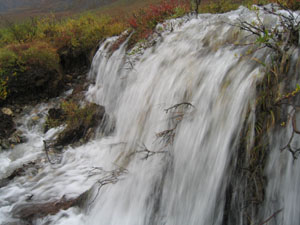 |
The valley was braided gravel all the way up, and mostly easy walking on gravel, terraces, and willow flats. It was sunny when we woke, and we could see the rocky gray mountains stretching away into the distance up and down our long valley.
|
|
I am falling asleep too much to write here tonight, and will continue tomorrow.
|
|
8/17/03 - day 15 (day 6 leg 2) |
| Over the mountains and into the flood |
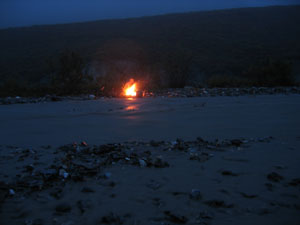 | Now it is evening, I'm sitting at a fire that's burned half the wood on this gravel bar, and I'm on the North Slope. We're now on the Hulahula River, and it looks a lot like the upper stretches of the East Fork Chandalar we just left.
|
Yesterday's journey up that river brought us our first bear of the trip. He galloped by to check us out, then came sauntering back past us for a second look. It was close enough I had the bear spray out, and I could feel the heart-pounding adrenaline rush that comes from facing a very large, very fast creature with big teeth. But like almost all bears, it ran from us. We inspected the fresh droppings, which looked like nothing more than tundra plants mixed up whole, and gave ourselves a prize for the first real bear sighting of the trip. It seems a wonder bears can get anything out of their food with that level of digestion.
| 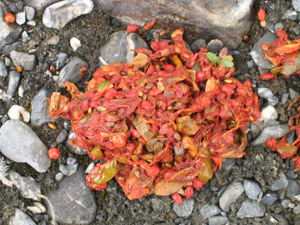 |
|
The rest of our walk up the river was free of wildlife, but the clouds gave us quite a show, alternately shadowing and revealing the surrounding peaks.
| 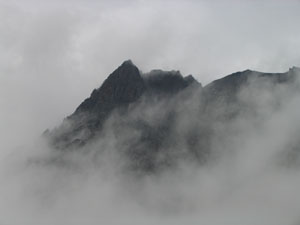 |
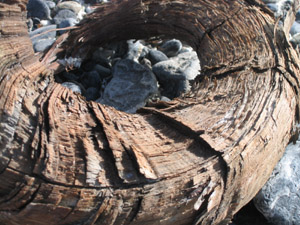 | We found a large ram's horn (maybe 2 feet long if stretched out) that had been washed ashore by the river. It was brown and weathered to the texture of stringy bark on the outside, and was full of horribly stinky anoxic black mud. It had clearly been buried for quite awhile. It looked a bit big to come from the sheep around here, but we haven't seen any close up yet, so who knows? It could be older. We toyed with the idea of carrying it, but decided it was too heavy, stinky, and illegal besides, so we took a bunch of pictures and left it on the banks.
|
We went crazy with pictures yesterday. All the mountains and clouds and colorful plants were just crying out to be photographed. I'm sure we will fill up just as many memory cards as we have with us.
|
We had to climb up a steep rocky hill in order to camp away from the major animal traffic zone. Its peak was littered with fossilized coral (we'd been finding some in the rivers too), which almost looked as if it was growing on the mountainside. The fog swept around us, and we could see nothing below our hilltop. The peaks on all sides eerily appeared and disappeared as the clouds swirled between them, providing our only visual link to the world. The thermarest padded our rocky bed, and I fell asleep quickly, hand still holding my pencil.
|
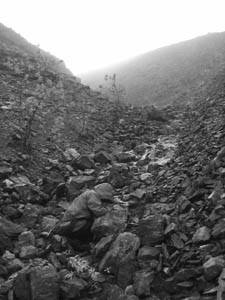 | Today was a day of further adventure. We climbed easily off our foggy hill, and made our way up the river to the pass. It was wet all day. The rain came not as a downpour, and rarely even as a drizzle, but as a persistent blowing mist that moistened the world. It was more than enough to make us and everything else quite wet. And this area has no capacity for water absorption. Even with as little rain as we've had the past few days, every stream and river is in flood. All the streams have turned from clear to muddy, and we're not camping on this gravel bar by our nice fire because we've watched the water rise at least three inches since we sat down. I would not like to wake up in the middle of the night to find myself marooned on a shrinking gravel island.
|
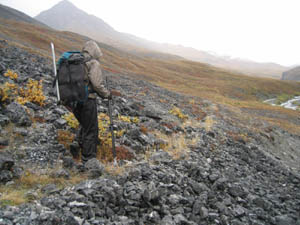 |
After a late morning's start (10ish) we trudged up and over the continental divide, following caribou trails into the mist. There was a lower and more obvious pass to the west of us, but there are so many caribou that I think they go in every direction. The occasion deserved to be marked, but there was nothing to see but the foggy talus slope we sat on. So we ate some prizes and I took a few silly pictures of Hig balancing an antler on his nose, but the divide was too cold and foggy for a comfortable rest. We headed down in short order. Down is where the real adventure came in.
| 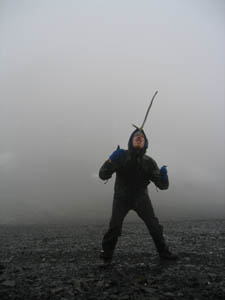 |
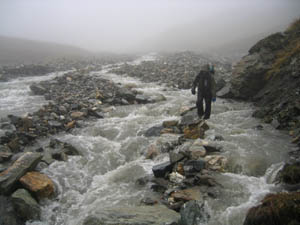 | The nice stream we followed up from the south was not matched by a similar stream on the north side. It was matched by a stream that was muddy, flooded, fast and steep, locked into gorges or walled by murderous slopes of too-steep talus. So we had to pick our way down, going sometimes along the stream, but often scrambling up and over to avoid riverside cliffs, trying to pick our way through the boulder fields that looked least likely to crash down on us. There were caribou trails along the river in places, which were helpful and hopeful signs that the way we were headed was in fact possible. The roar of rushing water was a constant throughout the descent, made even more ominous sounding by the echo in my rain hood. Every time we wanted to say anything we had to stop. As we scrambled past, we could hear the clacks and thuds of cobbles starting to move in the river as it rose in its flood.
| 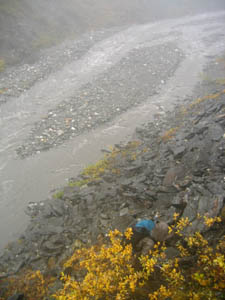 |
We had one quite technical stream crossing on the way down, with muddy opaque water, big rocks, and a steep gradient. It was rushing down the mountain in a grey-brown froth, and it definitely took the two of us to cross it. As a pair, we can cross what neither of us could alone. One person holds steady while the other one moves, wedging their feet between rocks or hiding from the current in the boil below a boulder. As the larger person, Hig stays upstream to break the current. We are each other's portable handholds, and we slowly leapfrog our way through the icy fast waters.
| 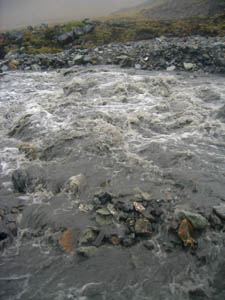 |
The waterfalls and gorges were impressive, but we were happy enough to get down into the flats. We were wet and cold and ahead of schedule, so we decided to stop early for a huge fire. The dots we marked on the map from Seattle often have little bearing on where we really walk, but they provide a good way to keep us on track for time. We burned lots of dead willow, made ourselves warm, and ate instant Quaker oatmeal packets with lots of butter. They're quite good that way.
|
We've made some nice hot rocks to keep us warm in bed, and now I must leave our gravel bar island for the shore. The water is rising, it's too dark to write well, and it's time for bed.
|
|
8/18/03 - day 16 (day 7 leg 2) |
| Whitewater |
Today our adventure continued. We're following the Hulahula River on foot until we can raft it down to the Arctic Ocean (with a probable side trip to visit Esetuk Glacier). The problem with this is figuring out when we can start rafting it. Rapids look a lot different from the shore than over the bow of a raft, and we never can see much of what will be downstream until we get there.
|
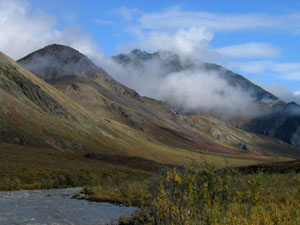 | So we spent the morning walking down the upper river, checking it out, discussing the rapids, and watching the sun play on the colorful mountains around us. This was all fine, until we hit the confluence. We'd been really hoping we could raft from this particular confluence (between the Hulahula and Itkillik Creek), since we were stuck in between them and figured we couldn't cross either without the raft. We'd have to blow the boats up anyway, so it would be great to just float from there. The river didn't look too bad just ahead of us. So we blew up the rafts and hopped in just where the bluish-white of Itkillik Creek swirled into the muddy grey waters of the Hulahula river.
|  |
|
Immediately, we were bouncing. I was working the paddle as quickly as I could, trying to steer the little blue boat away from holes, but the river had other ideas. The waves formed a range of muddy brown peaks, towering over me, pressing in from all sides, writhing and boiling. As I avoided the biggest, the rest of them flung themselves into my boat. The holes kept coming fast, and the boat got heavier and heavier with each passing wave. I was trying to steer a pool down the river. At this point, I wasn't so much avoiding the holes, just pointing the boat into whichever ones I was unfortunate enough to hit and hoping for the best. These Alpacka rafts bob surprisingly well. I kept my boat upright until it was so full that there was nothing for it but to paddle in to a gravel bar. I had a hell of a time trying to pull the pool of water far enough up onto the gravel bar that I could drain it. Hig wasn't quite so lucky as I and actually managed to get tossed out of his boat on one hole just before we stopped, but he climbed back in easily.
|
I'm not usually into thrilling rides and fast rafting, so I'd been psyching myself up for this all day. I was leading, and that's probably why we stayed in as long as we did. Aside from a few rapids that really deserved to be screamed at, it wasn't all that bad. Hig got dunked, we both got soaked, and we decided we might as well walk a bit further down the river until it got less steep. Now we know how the boats do in rapids.
| 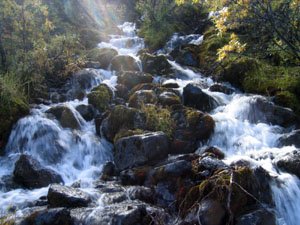 |
So we built a big fire, warmed up, ate oatmeal, and put our rafts away again. We also ate a good deal of our other food, in a moment of rationing failure. Rationing food is hard. I did allocate more food for this leg than the last, but not as much more as I ought to have, I guess. We had extra food when we got to Arctic Village, but we started out eating over quota on this leg, and are finding it harder to limit ourselves. We're not starving yet, but I'm daydreaming of pizza and mango smoothies, and we could easily scarf down any of our food bags if we let ourselves. I'll know I'm starving when I start daydreaming of trail mix.
|
One problem with being on the North Slope is that no large trees grow here. So despite the fact that we're following a big river valley, which is exactly where we expect the bears to be, there's nothing to tie the Ursacks to. A bear would be free to drag them off in the night, and I'm not ready to give up the rest of our food. We ran into a mother bear with two cubs today. It was definitely a good scare for all involved, I think. We got out the bear spray, and they ran past and away into a gully, checking us out periodically as they went. They acted just like the last bear we saw, but unlike the bears on the Alaska Peninsula. I wonder if the run-by technique is designed to allow the bear to check us out while foiling the aim of a hunter?
| 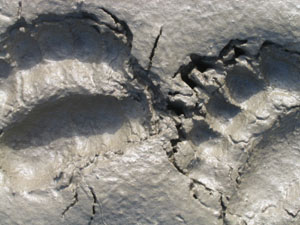 |
As well as bears, we saw whole flocks of sheep grazing the hillside across the river. It seemed that every fleck of white was moving, and the whole mountain was speckled with white leggy blobs. And as well as bears and sheep, we see people here.
|
|
We started seeing people sign almost as soon as we hit the river. We've found an empty and bear-chewed bottle of sore muscle rub, the wrapper of a block of cheese, cut marks on the willows where we built our first fire... Today we had several planes buzzing over us as we took our siesta on the gravel bar. And this evening, we saw tents. The yellow globes looked like strangely bright baubles on the other side of the river, drifting in and out of the descending fog. We didn't see the associated people, and it would have been too hard to yell across the river in any case. It was very surreal. We couldn't see where their plane must have landed, but we know now we're definitely below where people usually raft this. If they're rafters, anyway. I know it's a popular (as popular as anything gets around here) raft trip to go down the Hulahula. Most people go earlier in the year, but I'm sure that's what these people are doing. I wonder if we'll run into them.
| 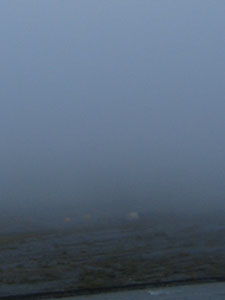 |
The river looks much gentler now, but still speedy, and tomorrow we should make good time on it. Right now we're camped well up the slope, hopefully well out of the way of traveling bears. The night is cold and damp again, and our rafts are mostly inflated and draped over our bivy sack for extra insulation. Now I will retreat fully into the sleeping bag.
|
|
Previous | Next
Page 1 | Page 2 | Page 3 | Page 4 | Page 5 | Page 6
|